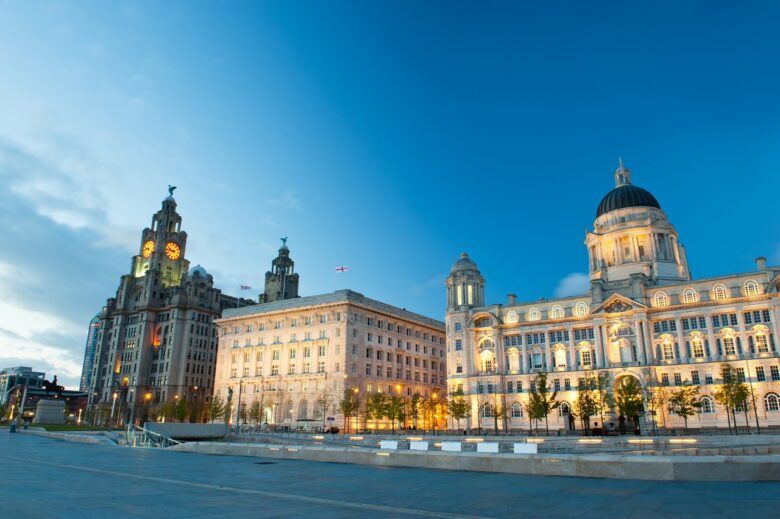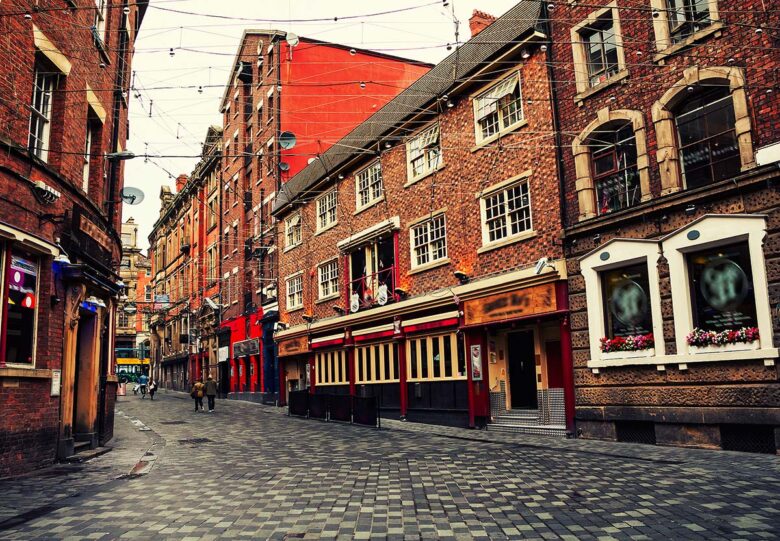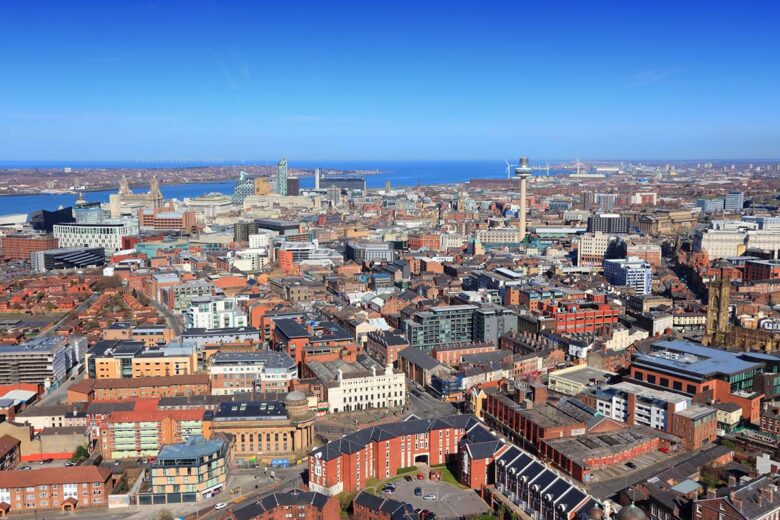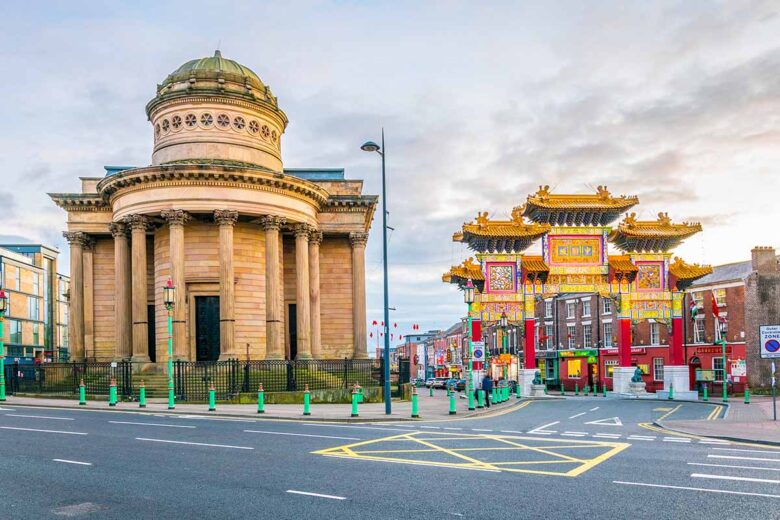
The best localities where to stay in Liverpool would be anywhere central, with the amenities attracting enough people to make it feel safe. There is a wide price range of hotels, and alternatives for students and backpackers. There is a better choice of the latter outside the centre, but there are also some hostels centrally placed.
Step off the train at Liverpool’s Lime Street station, and you’ll sense straightaway that you’re close to water. Something in the air makes it feel like arriving at the seaside, and the quality of the light beyond the bustling town centre will draw you towards the River Mersey without the need of signposts.
If you have already chosen where to stay in Liverpool, you can catch a local Merseyrail service from here (the price is often included in your mainline ticket), hop on a bus, or familiarise yourself with the city by walking.
As a once-busy port of world importance, Liverpool now boasts UNESCO World Heritage status as a Maritime Mercantile City. Centuries of arrivals from diverse cultures, who have settled here and added to the city’s make-up, have made it a welcoming and tolerant destination.
Today, it extends this hospitality to tourists and new residents, and there is plenty to do and see during your stay in Liverpool. Visitors will find a prosperous and lively city, with more museums and galleries than anywhere in the UK apart from London.
Where to stay in Liverpool: 7 Best areas
1. The City Centre, best area to stay in Liverpool

You’ll find the city centre right in front of you if you arrive by train, and you could stop for refreshments in one of Lime Street’s first-rate pubs.
Much of the shopping area is pedestrianised, and you’ll find everything you want in the department stores and smaller shops, with restaurants, cafés and bars where you can recharge your batteries.
Liverpool ONE is an innovative shopping centre that spills out onto surrounding streets, and includes a bus station. Every year, the Tickle the Ivories street festival allows passers-by to play one of the pianos dotted around the streets.
Liverpool, of course, is famous for its music history, especially the Beatles, and the site of manager Brian Epstein’s music store NEMS, and Beatles HQ (now demolished), is at 12-14 Whitechapel.
Brian Epstein met the Beatles at the Cavern Club on Mathew Street, now part of the Cavern Quarter, although it’s not the original building.
It attracts visitors from all over the world, who want to experience the place where the Beatles and other Mersey Sound groups gained popularity among local fans, and where Cilla Black was a cloakroom assistant.
The bands drank at two local pubs, the White Star and The Grapes, as the Cavern itself was unlicensed. You can still hear live music at the club, from where fans can book tours, and the surrounding area is popular for nightlife.
The facade to the shops of Mathew Street’s Cavern Walks showcases the Beatles, with John Lennon’s first wife Cythia having provided many ideas. The annual International Beatle Week draws in an international crowd, making it an ideal time for fans of sixties pop to stay in Liverpool.
Also in this area is St. George’s Quarter, displaying some of the country’s most impressive Victorian architecture. The magnificent neoclassical St. George’s Hall is just round the corner from William Brown Street, home to the Walker Art Gallery, World Museum and Central Library.
All have free admission, apart from special exhibitions, and if this isn’t enough culture, there are three theatres in the vicinity.
Don´t miss either the Liverpool Beatles Museum, St. John´s Gardens, the art centre The Bluecoat, The Radio City Tower, the Museum the Western Approaches,
Queen Square Arcade, on the edge of Queen Square bus station, contains eateries and entertainment.
Given its proximity to transport, retail and culture, this is probably one of the best areas to stay in Liverpool, with a choice between luxury hotels and serviced apartments, mid-price chains, a Beatles-themed option, pubs, Bed and Breakfast establishments, and hostels for those on a tight budget.
BEST PLACES TO STAY IN LIVERPOOL CITY CENTRE
2. Albert Dock, my favourite area in Liverpool

Once, the docks were the thriving heart of Liverpool’s industry and trade. Now, the waterfront has been re-invented as a pleasant place for a stroll, to meet friends, or a good location for anyone wanting to stay in Liverpool for a mini break.
Albert Dock, built in 1840, contains the UK’s biggest collection of Grade 1 listed buildings. Small shops and restaurants line its sides, together with Tate Liverpool art gallery (free apart from temporary shows).
Further along, The Beatles Story (which has an entry fee) is a magnet for fans and music lovers, who will find a linked shop and café at the Mersey Ferries Pier Head.
Discover the city’s seafaring past at the excellent Merseyside Maritime Museum, and don’t miss the International Slavery Museum (both free). The latter is an attempt by the citizens of Liverpool to confront their past, highlighting the city’s involvement with this appalling period, and detailing the unbearable lives of enslaved people.
Just along the waterfront from Albert Dock, the Museum of Liverpool uses its stunning architectural setting to chronicle the history of the city and its people, from the Ice Age onwards.
Try out a train carriage in the Liverpool Overhead Railway Gallery, and learn more about the world’s first electric elevated railway. It helped to deal with congestion along the docks, and was dubbed the dockers’ umbrella as it provided shelter from bad weather. Also popular with tourists due to its wonderful views of shipping on the Mersey, it sadly closed in 1956.
Carry on to the Mersey Ferries terminal for ferries, cruises, and trips along the Manchester Ship Canal. Hop on board the colourful Dazzle Ferry, designed by pop artist Peter Blake (creator of the Sergeant Pepper album cover) to commemorate World War One, when the patterns were employed to make ships hard to spot.
Outside the terminal, statues of the Fab Four greet travellers, while opposite the Pier Head, you’ll see the Three Graces: the Cunard Building, Port of Liverpool Building and the Royal Liver Building, where the two famous Liver Birds perch as they guard the port.
The Cunard building is currently home to the British Music Experience, and is also a location in the Harry Potter film Fantastic Beasts and Where To Find Them.
Admirers of Art Deco will love the Grade II-listed George Dock ventilation building, a splendid white tower complete with paintwork in that unique 1930s green, which provides ventilation for the road tunnel under the river.
The lively waterfront, with its proximity to the Arena and town centre shops, is another convenient area to stay in Liverpool, with some hotels offering extensive views over the wide Mersey.
A wide range of activities and festivities are centred around Albert Dock and on the river itself.
There is a wide range of accommodation in all price ranges. You will mostly find luxury and midrange hotels, but there are also a few budget options.
BEST PLACES TO STAY IN ALBERT DOCK
- ($$$) Crowne Plaza Liverpool City Centre, an IHG Hotel
- ($$) Pullman Liverpool
- ($) YHA Liverpool Albert Dock
3. Baltic Triangle, great nightlife

Once crowded with grim factories, the Baltic Triangle has transformed itself into a location buzzing with independent and creative startups in converted warehouses.
It’s a fifteen-minute walk from Liverpool ONE for daytime browsing, and lively nightlife with music, street food, and art.
The Baltic Market will fill you with delicious food while you take in a variety of events and festivals, including live music.
Watch out for street art and vintage shops, and discover some unusual ways of playing quizzes, bingo, golf and board games. Then go for a drink in a yellow submarine (of course).
You’ll be tired after all this, so opt for local accommodation – if you’re looking for somewhere reasonably-priced to stay in Liverpool, this would be worth looking at.
BEST PLACES TO STAY IN LIVERPOOL IN BALTIC TRIANGLE
- ($$) The Baltic Hotel
- ($$) The Halyard Liverpool, Vignette Collection, an IHG Hotel
- ($) Open Key Apartments
4. Knowledge Quarter and Georgian Quarter, one of the best areas to stay in Liverpool

Here, elegant Georgian houses reflect the city’s boom times. At one end of Hope Street sits the Cathedral Church of Christ, the UK’s largest Anglican cathedral, completed in 1978 by Sir Giles Gilbert Scott.
Book the Tower Experience for breathtaking views from the top of its one hundred metre-tall tower, reaching as far as Cheshire and North Wales, or do the same on the Twilight Tours in the summer months.
Among Scott’s other designs were works at Oxbridge, iconic Battersea Power Station, and the instantly-recognisable red telephone box (one of which is displayed near the cathedral’s tower lift!).
Further along, the Roman Catholic Metropolitan Cathedral was finished in 1967 by Sir Feredic Gibberd, after earlier proposals had come to nothing.
Stop to view the Lantern Tower, which boasts the world’s biggest area of coloured glass, and take in the Crypt, designed by renowned architect Sir Edwin Lutyens, who had submitted the original plans for the cathedral in the 1930s.
A theatre and a concert hall complete the line-up, with eateries and bars to visit before and after the shows.
The Georgian Quarter is also an excellent place to enjoy theatre and shows at the Royal Liverpool Philharmonic, the Hot Water Comedy Club, and the Unity Theatre. Further east, another iconic venue is the Yoko Ono Lennon Centre.
Leaving the main tourist trail, seek out the gem that is Mr Hardman’s Photographic Studio in Rodney Street, possibly the only complete example of a 20th-century photographic studio in the UK.
A portrait photographer by profession, landscape photography was his passion. Now run by the National Trust, pictures and processes are preserved, together with an insight into the lives of the inhabitants.
Wander along Mount Street, but don’t fall over the twenty-seven concrete cases outside the Liverpool Institute of Performing Arts, founded by Paul McCartney. “A Case History” by John King commemorates those who have added to the city’s culture (including Sir Paul).
With so much to see, why not choose one of the Knowledgre Quarter’s stylish boutique hotels for a special stay in Liverpool? It also has some student halls and flats, so expect it to be lively.
BEST PLACES TO STAY IN KNOWLEDGE QUARTER AND GEORGIAN QUARTER
5. Ropewalks, creative and innovative district

The craft of rope-making was essential to nineteenth-century ship owners and their crews, so it’s appropriate that the name has been given to this creative and innovative district.
Bold Street is one of its busiest thoroughfares, with shops, restaurants and street art.
Close to it is FACT, a leading gallery for everything in film, video and new media, while on the edge of Ropewalks, the Grade 1 listed 300-year-old Bluecoat is open all year.
Its comprehensive arts programme is complemented by independent shops, fresh local food and a sunny courtyard, making it a must to visit during your stay in Liverpool.
At the end of Bold Street stands the former Anglican church of St Luke’s, known as the Bombed Out Church. Destroyed in 1941 by an incendiary bomb in a blaze lasting three days, it has been preserved without a roof as a memorial to the four thousand deaths during World War Two bombing raids.
Most of the stained glass windows were lost, but a recently-found piece contains an image of a cormorant that would have been next to the main Bold Place doors. Some claim that this was actually the first Liver Bird, being a century earlier than the ones created for the Royal Liver Building.
Fittingly in this city of immigrants, a recent addition remembers those who died in the Irish potato famine of 1845 to 1852. St Luke’s has since found a new role as a venue for gigs, markets and weddings, and it is also famous for its Chinese New Year commemorations.
Chinatown itself at the end of Duke Street boasts a traditional arch imported from Shanghai, to mark the twinning of the two cities – there are strong ties due to the numbers of Chinese sailors who have settled here, and Liverpool is home to one of the oldest Chinese communities in Europe.
Ropewalks is a great destination for live music, bars, coffee shops and eateries, with the latest addition being the Duke Street Food Market.
With so much to see and do, and the proximity of Merseyrail’s Central Station, this is one of the best neighbourhoods in which to stay in Liverpool.
There is accommodation to suit all budgets and tastes, with self-catering among the options.
BEST PLACES TO STAY IN LIVERPOOL IN ROPE WALKS
6. Anfield and Everton, residential area with afordable accommodation

We leave the city centre to talk about the neighbourhoods of Everton and Anfield, two residential areas home to two great English Premier League teams: Everton and Liverpool.
Just north of the city centre, the ancient settlement of Everton was once a rural parish. Liverpool’s expansion led to prosperous families moving out to Everton, and it became part of the city in 1835.
Famous past residents include nineteenth-century author Thomas de Quincy, and Beatle Paul McCartney.
Situated in a less-affluent part of the city, it’s best known today for its football team, Everton FC, although the club has never been situated strictly within its constituency of Walton.
After failed proposals for other sites, the club hopes to move from its present home of Goodison Park to Bramley Moor Dock on the historic waterfront, giving a tremendous boost to this side of the city. It is still subject to approval as it’s within the World Heritage Site.
The neighbouring district of Anfield is home to Anfield Stadium and Liverpool FC, so if you are in town to see a football game of the The Reds there is no better area to stay in Liverpool.
The football crowd is catered for by bed and breakfast establishments, small hotels and apartments, but as it’s a more residential downmarket district, it might be easier to take advantage of good transport links to stay in Liverpool itself.
Book to Merseyrail’s Kirkdale Station or catch a bus from Queen Square in the city centre.
BEST PLACES TO STAY IN ANFIELD AND EVERTON
7. Crosby Beach, where to stay in Liverpool by the Beach

Covering three miles from the Port of Liverpool to the River Alt, sea views stretch from here to the Wirral, and as far as North Wales.
With the nearest Merseyrail stations at Blundellsands and Crosby, or Hall Road, and only twelve miles from Southport, the highlight of this sea walk has to be the one hundred iron figures looking out to sea over two miles, entitled Another Place.
Created by Anthony Gormley, sculptor of the imposing Angel of the North outside Gateshead, these casts of the artist’s body stand a kilometre from the beach, so that what is visible changes with the tides and seasons.
The original intention was to move them around the country, but Crosby suits them, and vice versa, so they will stay.
As you would expect at a seaside location, there is some small hotels and guest houses, but there are also the alternatives of central Liverpool, Southport, or Formby with its National Trust-owned nature reserve.
However, as Crosby is considered one of the best places to live in the North West, and one of the top coastal towns in the UK, this would be a great spot for a stay in Liverpool that gets you away from the crowds.
BEST PLACES TO STAY IN LIVERPOOL IN CROSSBY BEACH
- ($$) The Royal Hotel
- ($) Woodlands Guest House
- ($) The Lake House
You don’t need to go far to get a feel for this great maritime city, because there is so much history and present-day activity within walking distance, and the mix of locals and tourists gives it a safe feel.
Good transport links make it easy to move around, or to explore the surrounding region.
Sefton Park and its Palm House is a magnet for gardeners, while Speke Hall and Croxteth Hall will please history-lovers. Port Sunlight, built for the workers of Lever’s soap factory, is still a village, boasting a prestigious art gallery.